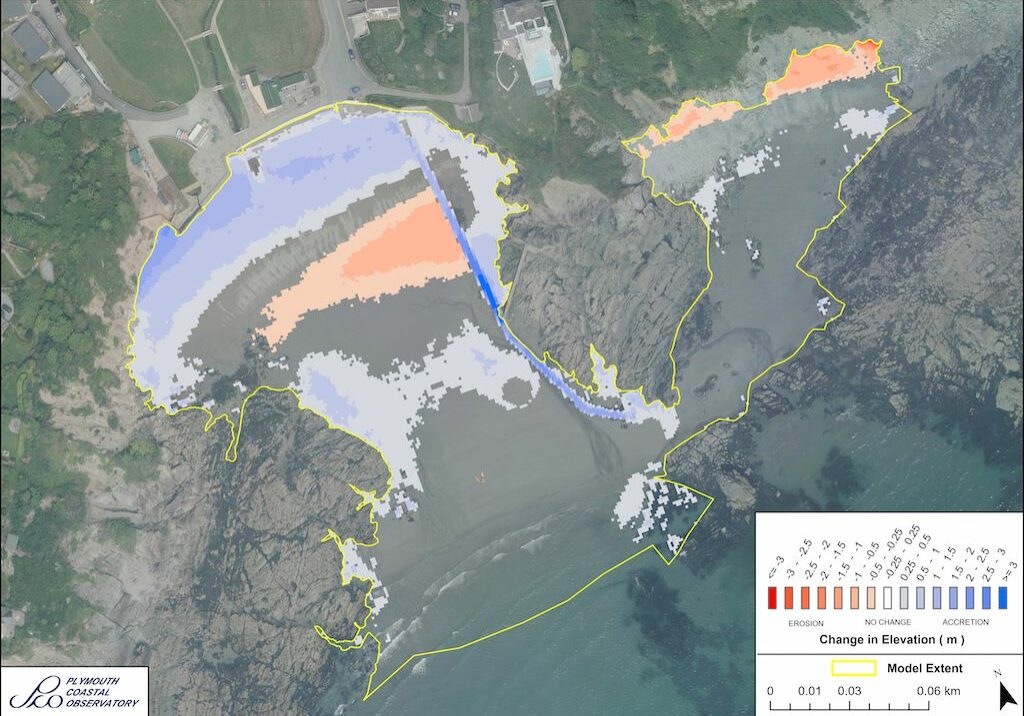
Millendreath (Cornish: Melindreth, meaning ‘mill on the beach’) is a south facing beach, within Looe Bay, in South East Cornwall.
Millendreath is located at the foot of a wooded valley, within a narrow and sheltered cove. The beach sediment consists of fine sand, fringed with rocks and steep cliffs. A seawall separates the hamlet of Millendreath from the beach. A small stream dissects the valley, the western side of which is dominated by a holiday village.
The uppershore of the beach is dominated by a seawall, which stretches the entire width of the beach, creating a boundary between the natural and built environment. With no space being available for the coastline to rollback, it makes parts of Millendreath more vulnerable to storm surges and more sensitive to sea level rise.


Coastal Change
The coastline of Cornwall is an ever-changing environment. It is energetic, dynamic, never still and changes with each wave and each tidal cycle. Some of the changes we see are gradual and barely noticeable, whilst others, such as rockfalls, happen suddenly and often shockingly.
From one visit to the next it can sometimes be difficult to see how a beach and dune system has changed, but information has been collected, and is being collected through the Making Space for Sand project, to help us better understand how the coastline is changing. The purpose of this section of the website is to understand each location has changed over time, how it could change in the future and understand the policies that influence how we can respond to these changes.
Shoreline Management Plans (SMP)
The Shoreline Management Plan (SMP) is a strategic planning and management assessment tool that helps identify and measure the risk associated coastal erosion and coastal flooding. The document makes a number of policy recommendations over short, medium and long term timeframes setting out a strategic approach to managing the built, natural and historic environments associated with the coastline. Within SMP there are four policy approaches which have been assigned to stretches of coastlines. The three policies are: No Active Intervention (NAI), Hold the Line (HTL), Managed realignment (MR).
Millendreath sits within Policy Development Zone 1 (PDZ1), in Management Area 3 (MA3), within Policy Unit (PU) 3.2. The policy recommendations for this unit are detailed in the table below and the SMP can be accessed through the Cornwall Council website.
Use your touchscreen
to scroll the below table
| Policy Unit | Policy Plan | ||||
| 2025 | 2055 | 2105 | Comment | ||
| 3.1 | Undefended cliffs and beaches
Main Policy Sub Policy
|
NAI DnD |
NAI DnD
|
NAI DnD |
Meets objectives of Heritage Coast, AONB and SSSI designations. Allow natural coastal evolution to occur to support conservation interest of protected sites. |
| 3.2 | Millendreath
Main Policy Sub Policy
|
NAI LAO |
NAI LAO |
NAI LAO |
Allow natural coastal evolution to occur to support conservation interest of protected sites. Subject to permissions, allow local activity to enable regeneration in the area whilst also enabling roll back of the shoreline to accommodate coastal change and avoid environmental deterioration. This approach will be monitored.
|
| 3.3 | Plaidy
Main Policy Sub Policy
|
HTL RnR |
NAI LAO |
NAI LAO |
Possible study required in Epoch 1 regarding cliff stability. Allow natural coastal evolution to occur to support conservation interest of protected sites. In near term this will involve maintenance of existing localised assets. Future local activity is subject to further study of cliff stability, issues arising from defence outflanking and assessment of any impacts on protected sites. |
| Key Main Policy: HTL – Hold the Line, A – Advance the Line, NAI – No Active Intervention, MR – Managed Realignment
Sub Policy: DnD – Do not Defend, LAO – Local Activity Only, RnR – Repair not Replace |
|||||


National Coastal Erosion Risk Mapping (NCERM)
National Coastal Erosion Risk Mapping (NCERM) provides a baseline of coastal erosion, for the coastline of England, over short, medium and long-term timeframes. The data is based on the natural and defence characteristics of the coastline and provides rates of erosion at differing levels of confidence to help better plan for worse case scenarios. The data provided is for guidance and does not estimate the absolute location of the future coastline.
The basic NCERM lines show erosion estimates for the Short Term (ST-20 years), Medium Term (MT-50 years) and Long Term (LT- 100 years). The data is further categorised by probability: 05 is 5% probability (a 1 in 20 chance of being exceeded) Red Shading, 50 is 50% probability of being exceeded (a 1 in 2 chance of being either exceeded or not exceeded) Orange Shading and 95 is 95% probability (a 19 in 20 chance of being exceeded) Yellow Shading. Click the link below to access the Cornwall Council NCERM Mapping site.

Modelling Coastal Change

Using data that has already been collected, combined with data collected through the Making Space for Sand project, a series of models will be carried out at each location. This will help us better understand how each location may respond to sea level rise and gain a deeper understanding of how coastal sediments move and behave.
The complexity of the modelling, and the data collection that helps inform it, means that modelling outputs will not be the same on all sites. Some locations will be more thoroughly investigated to understand more complex issues and provide data that can be more widely applied to other sites with similar characteristics.
As the project develops this section of the website will expand, sharing new reports and coastal change projections when they are produced.
LiDAR surveys, which are explained on the Data Modelling page, have been carried out by the South West Coastal Monitoring program at this location. The image shared here visualises where sand has eroded (areas shaded in red) and where it has built up (areas shaded in blue), between the LiDAR surveys carried out in 2008 and 2020. The darker the shade of red or blue the greater the amount of sand erosion or accumulation has been observed. The image helps visualise that beaches are areas that change shape over time and will continue to do so as sea levels rise.


Designations
The coastline represents an important transition between the marine environment and the terrestrial environment. This transition creates a range of special habitats and exposes a range of interesting features, which that can result in these spaces being highly designated and protected. There are a range of designations that recognise a variety of different features. At this location these designations are explored below.
Marine Conservation Zone (MCZ)
A Marine Conservation Zone (MCZ) is a type of marine protected area, designated in English, Welsh and Northern Ireland territorial offshore waters, to protect a range of nationally important, rare or threatened marine habitats or species by halting or reversing damage and degradation caused by human activities.
The Whitsand and Looe Bay MCZ covers an area of 52km2, extending along the mean high water mark from Portnadler Bay to Rame Head. The sediment supports populations of bivalve molluscs and marine worms and provides a habitat for commercially important fish and shellfish, while the site’s intertidal rocky habitats are characterised by animals such as sponges, sea squirts and the rare giant goby. Further out to sea there are shipwrecks and small areas of subtidal rocky reef that support pink sea-fans and rare sea-fan anemones.
Image of an assortment of seaweed (Courtesy of Susan Scott)
Sign up to Making Space for Sand
If you would like to get involved in helping to make dunes more resilient and biodiverse, want to help develop coastal adaptation and emergency plans or just want to know more about what the project is learning about coastal change, please click here:


